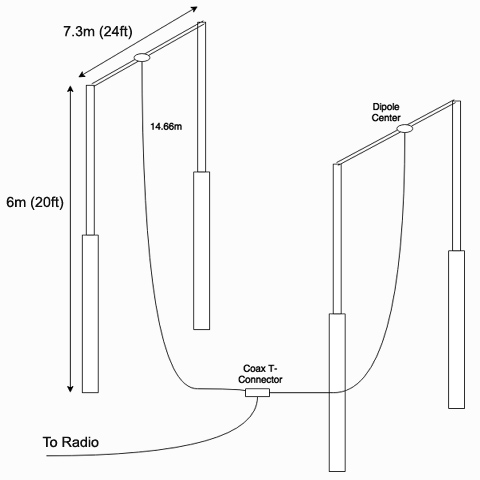Wireless Waffle has previously discussed the idea that it might be possible to receive radio transmissions from alien planets, but it might not be widely recognised that it is possible to receive radio transmissions from planets within our very own solar system!
 It turns out that the planet Jupiter emits a range of different radio transmissions, not from people using mobile phones on the planet's surface, but so called long 'L' bursts and short 'S' bursts which are generated by the planet itself and its interaction with its moons, and that these signals are relatively easy to receive here on good old planet Earth. These emissions range in frequency from a few kHz to around 40 MHz. The Jovian signals get weaker the higher in frequency you go, but the lower frequencies are often absorbed by the Earth's ionosphere. In addition, many of these frequencies can be replete with short-wave transmissions. What is needed, therefore, is a frequency that is high enough to pass relatively unperturbed through the ionosphere, but low enough to be receiveable, without too much interference.
It turns out that the planet Jupiter emits a range of different radio transmissions, not from people using mobile phones on the planet's surface, but so called long 'L' bursts and short 'S' bursts which are generated by the planet itself and its interaction with its moons, and that these signals are relatively easy to receive here on good old planet Earth. These emissions range in frequency from a few kHz to around 40 MHz. The Jovian signals get weaker the higher in frequency you go, but the lower frequencies are often absorbed by the Earth's ionosphere. In addition, many of these frequencies can be replete with short-wave transmissions. What is needed, therefore, is a frequency that is high enough to pass relatively unperturbed through the ionosphere, but low enough to be receiveable, without too much interference.
An obvious place to start would be the Radio Astronomy frequency allocation between 25.55 and 25.67 MHz as these frequencies should theoretically be free of all other radio transmissions. But it seems the frequency of preference for catching the latest bursts from Jupiter is actually 20.1 MHz, which is the frequency selected by NASA's Radio Jove project. From a radio spectrum perspective this is a relatively odd choice of frequency (e.g compared to the theoretically clean Radio Astronomy allocation). At an international level, frequencies around 20.1 MHz are allocated primarily to the fixed service, with a secondary allocation to mobile services. A quick scan of the Globaltuners database shows AT&T usage on 20.095 MHz and US Civil Air Patrol on 20.107 MHz. However, it seems that the signals from Jupiter at higher frequencies are much weaker, even by the time 25 MHz is reached.
 So what do you need to listen to these mysterious signals? A simple short-wave radio should do the job, however it is said that there are two additional things which need to be done in order to tune in to Jupiter:
So what do you need to listen to these mysterious signals? A simple short-wave radio should do the job, however it is said that there are two additional things which need to be done in order to tune in to Jupiter:
The latter of these is the most difficult. A two-element array is what the experts say is needed, and at 20 MHz, this is roughly 8 metres (26 feet) square as the diagram on the right shows.
Notwithstanding a lack of the correct antenna, Wireless Waffle sought to attempt to receive Jovian radio signals using a short-wave receiver and a normal short-wave antenna (not the fancy two-element arrangement). Sadly, our attempts did not yield any L or S bursts that could be definitively identified as transmissions from Jupiter. We did however manage to receive:
 It turns out that the planet Jupiter emits a range of different radio transmissions, not from people using mobile phones on the planet's surface, but so called long 'L' bursts and short 'S' bursts which are generated by the planet itself and its interaction with its moons, and that these signals are relatively easy to receive here on good old planet Earth. These emissions range in frequency from a few kHz to around 40 MHz. The Jovian signals get weaker the higher in frequency you go, but the lower frequencies are often absorbed by the Earth's ionosphere. In addition, many of these frequencies can be replete with short-wave transmissions. What is needed, therefore, is a frequency that is high enough to pass relatively unperturbed through the ionosphere, but low enough to be receiveable, without too much interference.
It turns out that the planet Jupiter emits a range of different radio transmissions, not from people using mobile phones on the planet's surface, but so called long 'L' bursts and short 'S' bursts which are generated by the planet itself and its interaction with its moons, and that these signals are relatively easy to receive here on good old planet Earth. These emissions range in frequency from a few kHz to around 40 MHz. The Jovian signals get weaker the higher in frequency you go, but the lower frequencies are often absorbed by the Earth's ionosphere. In addition, many of these frequencies can be replete with short-wave transmissions. What is needed, therefore, is a frequency that is high enough to pass relatively unperturbed through the ionosphere, but low enough to be receiveable, without too much interference. An obvious place to start would be the Radio Astronomy frequency allocation between 25.55 and 25.67 MHz as these frequencies should theoretically be free of all other radio transmissions. But it seems the frequency of preference for catching the latest bursts from Jupiter is actually 20.1 MHz, which is the frequency selected by NASA's Radio Jove project. From a radio spectrum perspective this is a relatively odd choice of frequency (e.g compared to the theoretically clean Radio Astronomy allocation). At an international level, frequencies around 20.1 MHz are allocated primarily to the fixed service, with a secondary allocation to mobile services. A quick scan of the Globaltuners database shows AT&T usage on 20.095 MHz and US Civil Air Patrol on 20.107 MHz. However, it seems that the signals from Jupiter at higher frequencies are much weaker, even by the time 25 MHz is reached.
 So what do you need to listen to these mysterious signals? A simple short-wave radio should do the job, however it is said that there are two additional things which need to be done in order to tune in to Jupiter:
So what do you need to listen to these mysterious signals? A simple short-wave radio should do the job, however it is said that there are two additional things which need to be done in order to tune in to Jupiter:- Turn off the AGC (automatic gain control) on the receiver. The AGC apparently tends to mask the bursts. A software radio is ideal for this.
- Build a simple directional antenna.
The latter of these is the most difficult. A two-element array is what the experts say is needed, and at 20 MHz, this is roughly 8 metres (26 feet) square as the diagram on the right shows.
Notwithstanding a lack of the correct antenna, Wireless Waffle sought to attempt to receive Jovian radio signals using a short-wave receiver and a normal short-wave antenna (not the fancy two-element arrangement). Sadly, our attempts did not yield any L or S bursts that could be definitively identified as transmissions from Jupiter. We did however manage to receive:

- Venus
- Neptune and
- A Girl from Mars
2 comments
( 1098 views )
| permalink
| 



 ( 2.9 / 4411 )
( 2.9 / 4411 )




 ( 2.9 / 4411 )
( 2.9 / 4411 )

